Abstract
Epidermal growth factor (EGF) reproduces many of the effects of estrogen on the murine female reproductive tract and may partially mediate estrogen-induced growth and differentiation. This study was performed to investigate the mechanism by which EGF elicits estrogen-like actions in the whole animal. EGF was administered to adult ovariectomized mice by slow release pellets implanted under the kidney capsule. The induction of uterine DNA synthesis and phosphatidylinositol lipid turnover by EGF or administration of diethylstilbestrol (5 micrograms/kg), a potent estrogen, was attenuated by the estrogen receptor antagonist ICI 164,384. Furthermore, EGF mimicked the effects of estrogen on enhanced nuclear localization of the estrogen receptor and the formation of a unique form of the estrogen receptor found exclusively in the nucleus. These results suggest that EGF may induce effects similar to those of estrogen in the mouse uterus by an interaction between the EGF signaling pathway and the classical estrogen receptor. The demonstration of cross-talk between polypeptide growth factors and steroid hormone receptors may be of importance to our understanding of the regulation of normal growth and differentiation as well as the mechanisms of transmission of extracellular mitogen signals to the nucleus.
Full text
PDF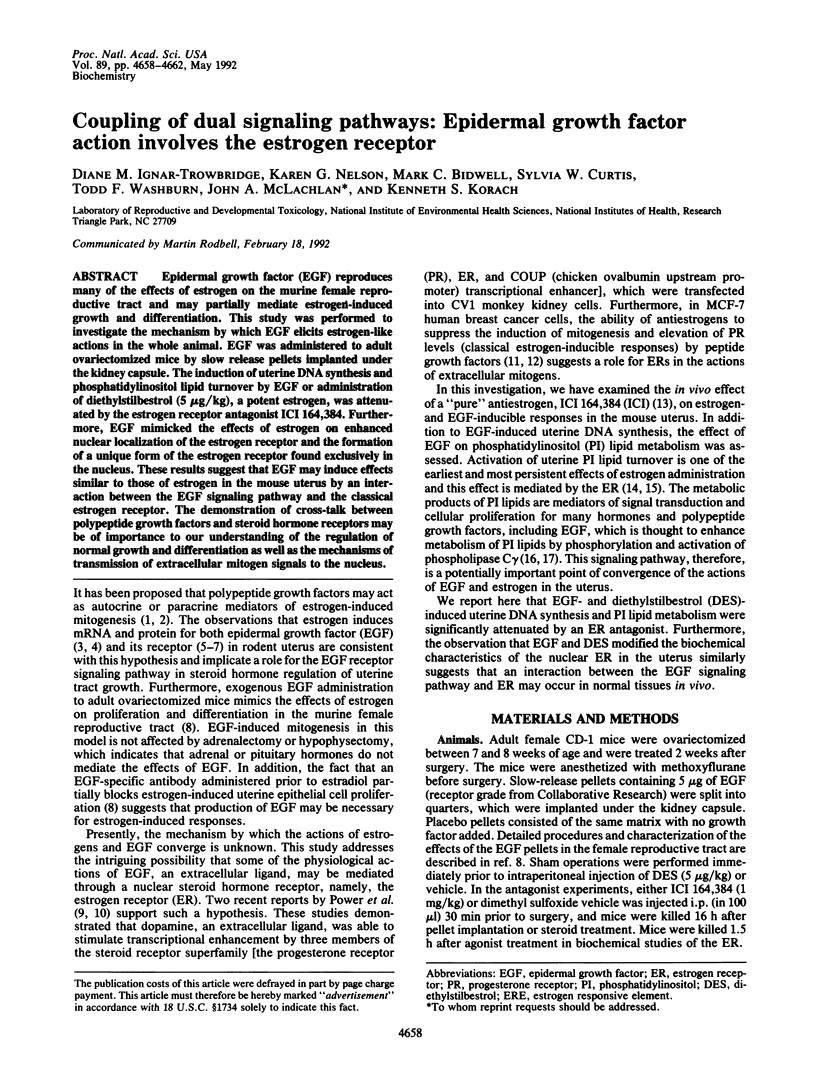
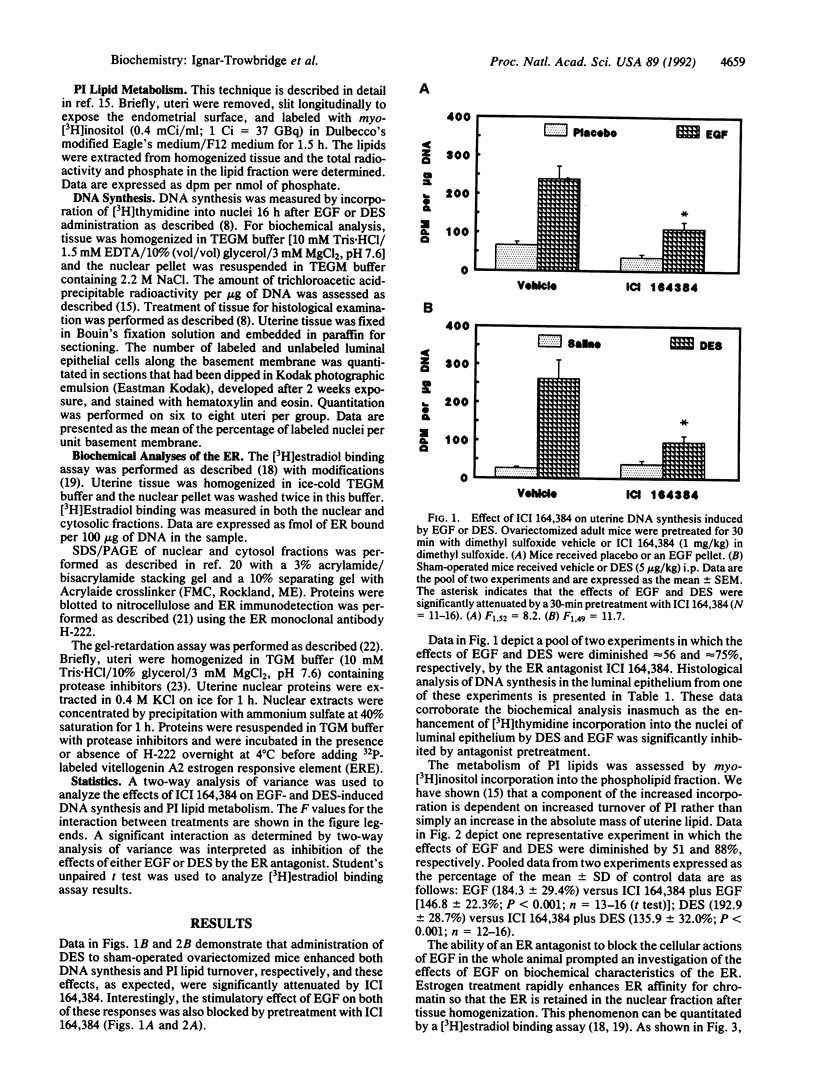
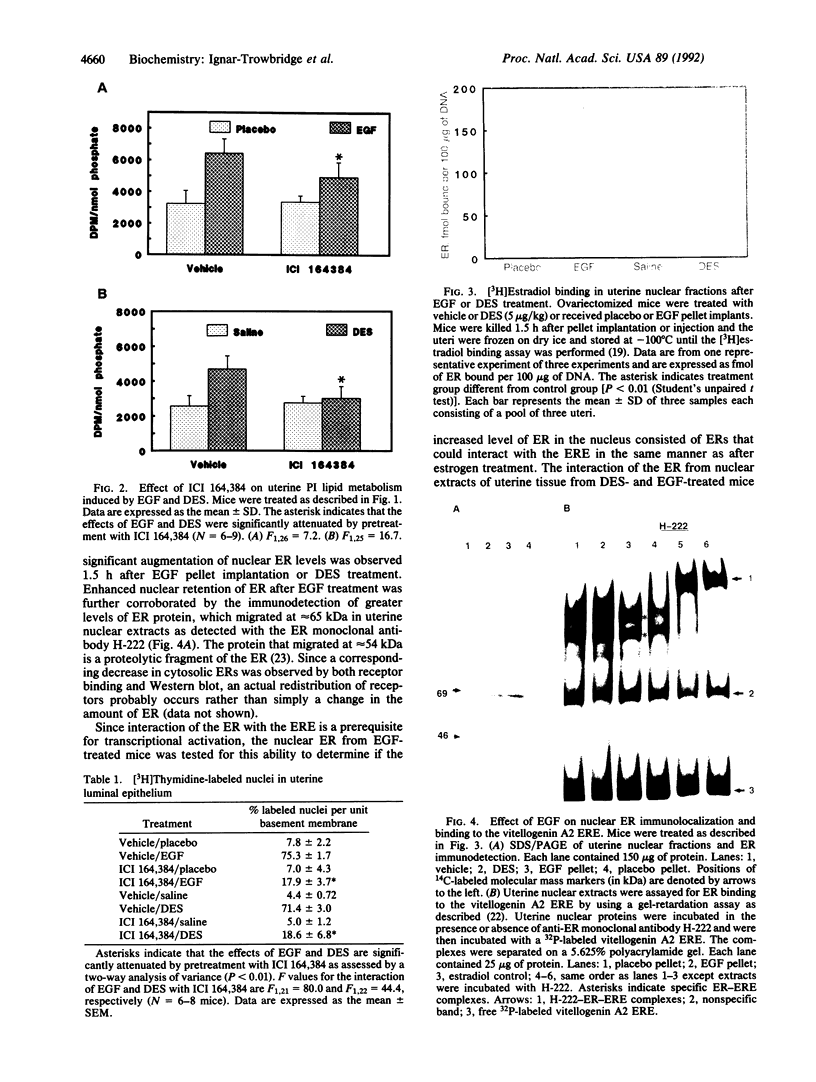
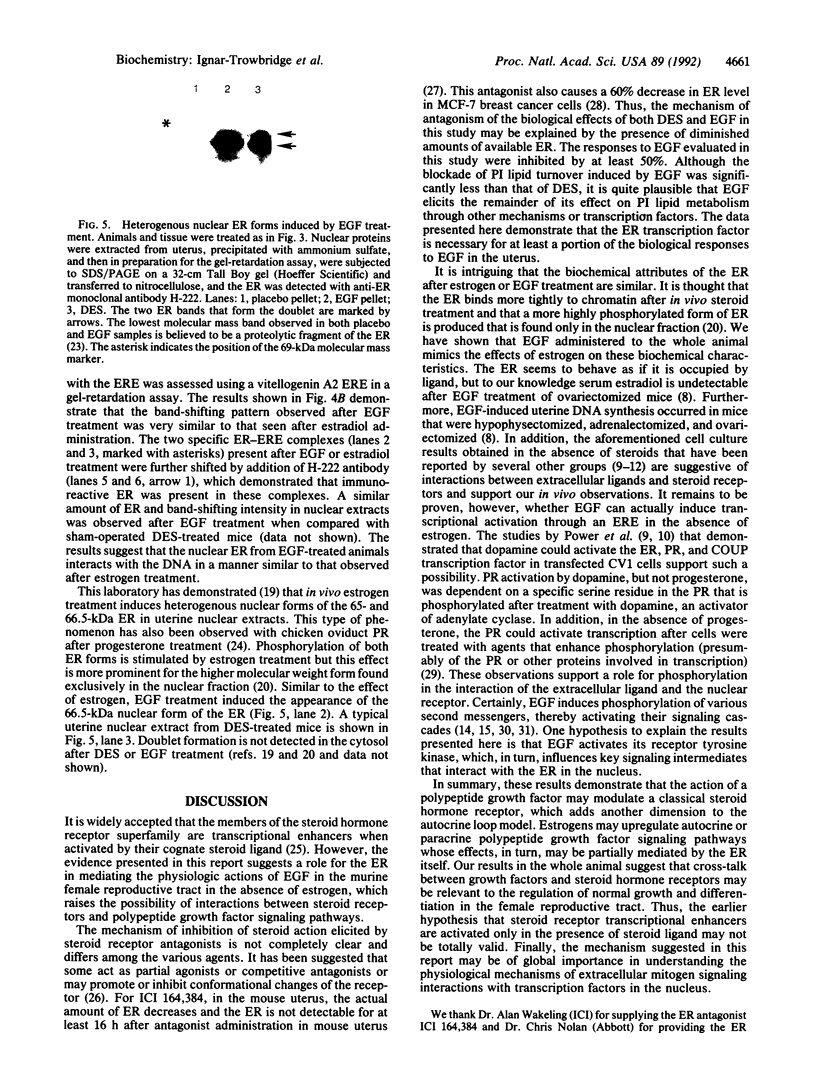
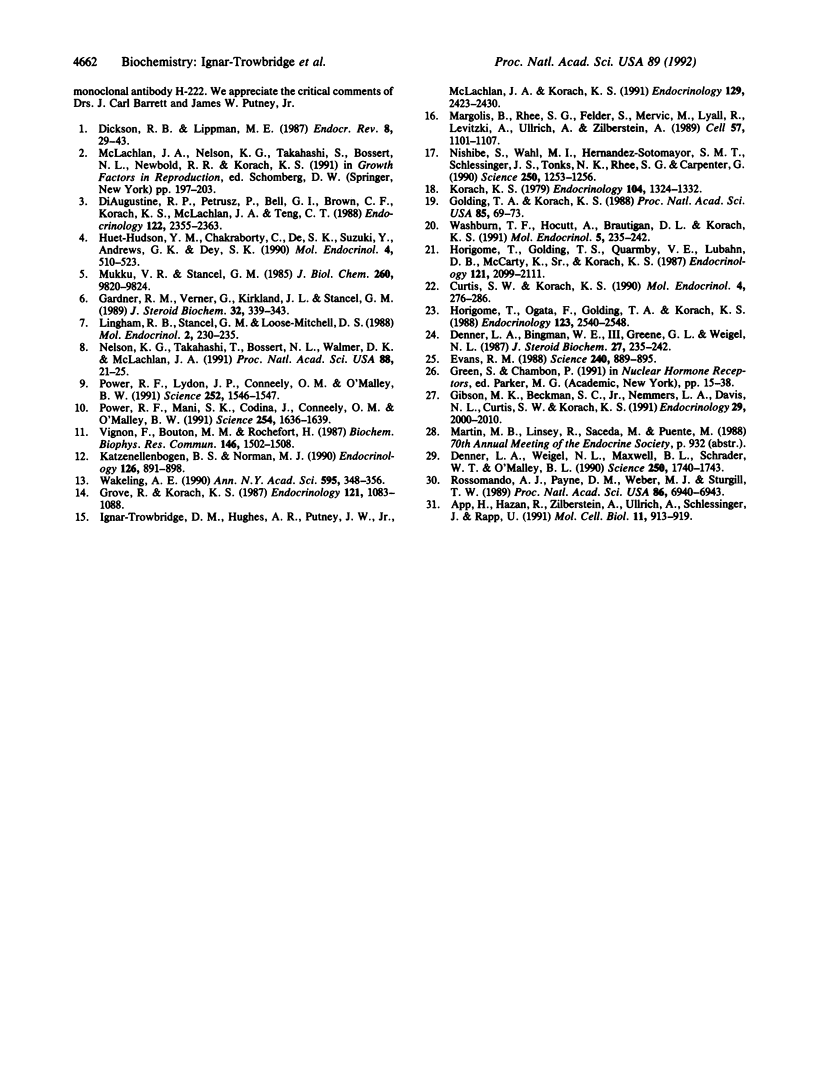
Images in this article
Selected References
These references are in PubMed. This may not be the complete list of references from this article.
- App H., Hazan R., Zilberstein A., Ullrich A., Schlessinger J., Rapp U. Epidermal growth factor (EGF) stimulates association and kinase activity of Raf-1 with the EGF receptor. Mol Cell Biol. 1991 Feb;11(2):913–919. doi: 10.1128/mcb.11.2.913. [DOI] [PMC free article] [PubMed] [Google Scholar]
- Curtis S. W., Korach K. S. Uterine estrogen receptor interaction with estrogen-responsive DNA sequences in vitro: effects of ligand binding on receptor-DNA complexes. Mol Endocrinol. 1990 Feb;4(2):276–286. doi: 10.1210/mend-4-2-276. [DOI] [PubMed] [Google Scholar]
- Denner L. A., Bingman W. E., 3rd, Greene G. L., Weigel N. L. Phosphorylation of the chicken progesterone receptor. J Steroid Biochem. 1987;27(1-3):235–243. doi: 10.1016/0022-4731(87)90315-3. [DOI] [PubMed] [Google Scholar]
- Denner L. A., Weigel N. L., Maxwell B. L., Schrader W. T., O'Malley B. W. Regulation of progesterone receptor-mediated transcription by phosphorylation. Science. 1990 Dec 21;250(4988):1740–1743. doi: 10.1126/science.2176746. [DOI] [PubMed] [Google Scholar]
- DiAugustine R. P., Petrusz P., Bell G. I., Brown C. F., Korach K. S., McLachlan J. A., Teng C. T. Influence of estrogens on mouse uterine epidermal growth factor precursor protein and messenger ribonucleic acid. Endocrinology. 1988 Jun;122(6):2355–2363. doi: 10.1210/endo-122-6-2355. [DOI] [PubMed] [Google Scholar]
- Dickson R. B., Lippman M. E. Estrogenic regulation of growth and polypeptide growth factor secretion in human breast carcinoma. Endocr Rev. 1987 Feb;8(1):29–43. doi: 10.1210/edrv-8-1-29. [DOI] [PubMed] [Google Scholar]
- Evans R. M. The steroid and thyroid hormone receptor superfamily. Science. 1988 May 13;240(4854):889–895. doi: 10.1126/science.3283939. [DOI] [PMC free article] [PubMed] [Google Scholar]
- Gardner R. M., Verner G., Kirkland J. L., Stancel G. M. Regulation of uterine epidermal growth factor (EGF) receptors by estrogen in the mature rat and during the estrous cycle. J Steroid Biochem. 1989 Mar;32(3):339–343. doi: 10.1016/0022-4731(89)90205-7. [DOI] [PubMed] [Google Scholar]
- Gibson M. K., Nemmers L. A., Beckman W. C., Jr, Davis V. L., Curtis S. W., Korach K. S. The mechanism of ICI 164,384 antiestrogenicity involves rapid loss of estrogen receptor in uterine tissue. Endocrinology. 1991 Oct;129(4):2000–2010. doi: 10.1210/endo-129-4-2000. [DOI] [PubMed] [Google Scholar]
- Golding T. S., Korach K. S. Nuclear estrogen receptor molecular heterogeneity in the mouse uterus. Proc Natl Acad Sci U S A. 1988 Jan;85(1):69–73. doi: 10.1073/pnas.85.1.69. [DOI] [PMC free article] [PubMed] [Google Scholar]
- Grove R. I., Korach K. S. Estrogen stimulation of phosphatidylinositol metabolism in mouse uterine tissue. Endocrinology. 1987 Sep;121(3):1083–1088. doi: 10.1210/endo-121-3-1083. [DOI] [PubMed] [Google Scholar]
- Horigome T., Golding T. S., Quarmby V. E., Lubahn D. B., McCarty K., Sr, Korach K. S. Purification and characterization of mouse uterine estrogen receptor under conditions of varying hormonal status. Endocrinology. 1987 Dec;121(6):2099–2111. doi: 10.1210/endo-121-6-2099. [DOI] [PubMed] [Google Scholar]
- Horigome T., Ogata F., Golding T. S., Korach K. S. Estradiol-stimulated proteolytic cleavage of the estrogen receptor in mouse uterus. Endocrinology. 1988 Nov;123(5):2540–2548. doi: 10.1210/endo-123-5-2540. [DOI] [PubMed] [Google Scholar]
- Huet-Hudson Y. M., Chakraborty C., De S. K., Suzuki Y., Andrews G. K., Dey S. K. Estrogen regulates the synthesis of epidermal growth factor in mouse uterine epithelial cells. Mol Endocrinol. 1990 Mar;4(3):510–523. doi: 10.1210/mend-4-3-510. [DOI] [PubMed] [Google Scholar]
- Ignar-Trowbridge D. M., Hughes A. R., Putney J. W., Jr, McLachlan J. A., Korach K. S. Diethylstilbestrol stimulates persistent phosphatidylinositol lipid turnover by an estrogen receptor-mediated mechanism in immature mouse uterus. Endocrinology. 1991 Nov;129(5):2423–2430. doi: 10.1210/endo-129-5-2423. [DOI] [PubMed] [Google Scholar]
- Katzenellenbogen B. S., Norman M. J. Multihormonal regulation of the progesterone receptor in MCF-7 human breast cancer cells: interrelationships among insulin/insulin-like growth factor-I, serum, and estrogen. Endocrinology. 1990 Feb;126(2):891–898. doi: 10.1210/endo-126-2-891. [DOI] [PubMed] [Google Scholar]
- Korach K. S. Estrogen action in the mouse uterus: characterization of the cytosol and nuclear receptor systems. Endocrinology. 1979 May;104(5):1324–1332. doi: 10.1210/endo-104-5-1324. [DOI] [PubMed] [Google Scholar]
- Lingham R. B., Stancel G. M., Loose-Mitchell D. S. Estrogen regulation of epidermal growth factor receptor messenger ribonucleic acid. Mol Endocrinol. 1988 Mar;2(3):230–235. doi: 10.1210/mend-2-3-230. [DOI] [PubMed] [Google Scholar]
- Margolis B., Rhee S. G., Felder S., Mervic M., Lyall R., Levitzki A., Ullrich A., Zilberstein A., Schlessinger J. EGF induces tyrosine phosphorylation of phospholipase C-II: a potential mechanism for EGF receptor signaling. Cell. 1989 Jun 30;57(7):1101–1107. doi: 10.1016/0092-8674(89)90047-0. [DOI] [PubMed] [Google Scholar]
- Mukku V. R., Stancel G. M. Regulation of epidermal growth factor receptor by estrogen. J Biol Chem. 1985 Aug 15;260(17):9820–9824. [PubMed] [Google Scholar]
- Nelson K. G., Takahashi T., Bossert N. L., Walmer D. K., McLachlan J. A. Epidermal growth factor replaces estrogen in the stimulation of female genital-tract growth and differentiation. Proc Natl Acad Sci U S A. 1991 Jan 1;88(1):21–25. doi: 10.1073/pnas.88.1.21. [DOI] [PMC free article] [PubMed] [Google Scholar]
- Nishibe S., Wahl M. I., Hernández-Sotomayor S. M., Tonks N. K., Rhee S. G., Carpenter G. Increase of the catalytic activity of phospholipase C-gamma 1 by tyrosine phosphorylation. Science. 1990 Nov 30;250(4985):1253–1256. doi: 10.1126/science.1700866. [DOI] [PubMed] [Google Scholar]
- Power R. F., Lydon J. P., Conneely O. M., O'Malley B. W. Dopamine activation of an orphan of the steroid receptor superfamily. Science. 1991 Jun 14;252(5012):1546–1548. doi: 10.1126/science.2047861. [DOI] [PubMed] [Google Scholar]
- Power R. F., Mani S. K., Codina J., Conneely O. M., O'Malley B. W. Dopaminergic and ligand-independent activation of steroid hormone receptors. Science. 1991 Dec 13;254(5038):1636–1639. doi: 10.1126/science.1749936. [DOI] [PubMed] [Google Scholar]
- Rossomando A. J., Payne D. M., Weber M. J., Sturgill T. W. Evidence that pp42, a major tyrosine kinase target protein, is a mitogen-activated serine/threonine protein kinase. Proc Natl Acad Sci U S A. 1989 Sep;86(18):6940–6943. doi: 10.1073/pnas.86.18.6940. [DOI] [PMC free article] [PubMed] [Google Scholar]
- Vignon F., Bouton M. M., Rochefort H. Antiestrogens inhibit the mitogenic effect of growth factors on breast cancer cells in the total absence of estrogens. Biochem Biophys Res Commun. 1987 Aug 14;146(3):1502–1508. doi: 10.1016/0006-291x(87)90819-9. [DOI] [PubMed] [Google Scholar]
- Wakeling A. E. Novel pure antiestrogens. Mode of action and therapeutic prospects. Ann N Y Acad Sci. 1990;595:348–356. doi: 10.1111/j.1749-6632.1990.tb34308.x. [DOI] [PubMed] [Google Scholar]
- Washburn T., Hocutt A., Brautigan D. L., Korach K. S. Uterine estrogen receptor in vivo: phosphorylation of nuclear specific forms on serine residues. Mol Endocrinol. 1991 Feb;5(2):235–242. doi: 10.1210/mend-5-2-235. [DOI] [PubMed] [Google Scholar]





